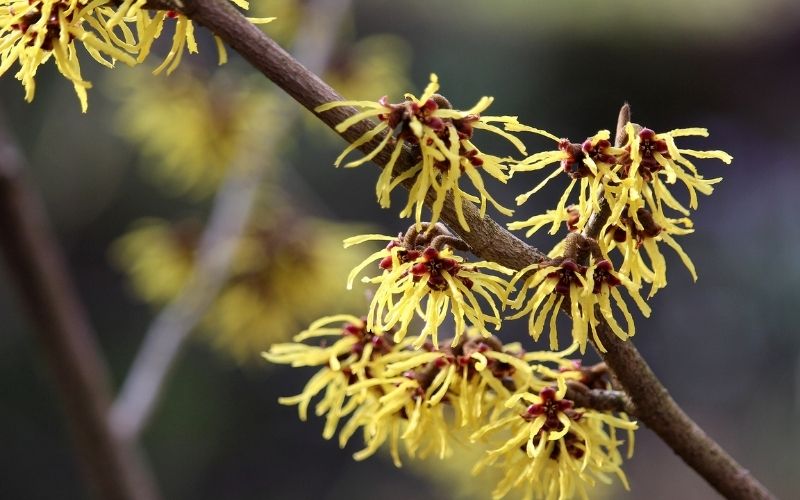Witch hazel is a botanical ingredient used in holistic medicine to treat acne, inflammation, open wounds, sunburn, insect bites, and even varicose veins and hemorrhoids.
But is witch hazel a good treatment for those with oily and acne-prone skin?
Witch hazel can help soothe inflammation and reduce acne. However, incorrect use can leave the skin dry and damaged, which could potentially exacerbate this inflammatory condition in the long term.
Therefore, if you’re thinking of trying witch hazel to get rid of acne and keep excess oil under control, here’s everything you need to know about this ingredient and how to use it correctly for the best results and no side effects.

What is Witch Hazel?
Witch hazel is a plant that grows wild throughout North America and Asia.
It is known by its Latin name, Hamamelis Virginiana, which is the name that you will most likely see on the ingredient list of skincare products containing witch hazel.
Witch hazel can be found in anything from cleansers, serums, and moisturizers, but it is most commonly used in toners and astringents.
Witch hazel is typically prepared by boiling the leaves and bark in water and distilling the concoction by mixing it with some type of alcohol, such as ethanol, to extract its beneficial properties.
This process yields a liquid extract that retains the plant’s key compounds, including tannins, flavonoids, and essential oils, which contribute to its therapeutic effects.
Is Witch Hazel Good for Oily Skin?
Witch hazel can temporarily reduce excess oil and shine; however, it can also be drying to the skin and cause it to peel, flake, and become irritated.
As already mentioned, witch hazel is usually prepared by boiling the leaves and bark in water and distilling the concoction by mixing it with some type of alcohol, such as ethanol, which can dehydrate the skin.
“Almost all witch hazel products rely on the skin-damaging type of alcohol to extract the plant for use in skincare. Up to 15% of that alcohol remains in the product, and research is clear that much lower amounts than that can trigger skin cell death and barrier damage”
– says Paula Begoun, the woman behind Paula’s Choice, one of the world’s most popular skincare brands.
Additionally, like many plant-derived components, witch hazel is also a source of several antioxidants, many of which benefit the skin short-term; however, one main antioxidant is a group of chemicals known as tannins.
Tannins in witch hazel compress proteins in your skin, causing it to shrink while dissolving the natural oil on the skin’s surface.
This effect helps reduce shine temporarily, making ingredients such as witch hazel marketable to those with oily skin.
Does Witch Hazel Help Acne?

Witch hazel contains anti-inflammatory components that can help soothe acne; however, it can also be drying to the skin, leaving it vulnerable to pathogenic overgrowth over time.
While the effect of reduced shine is temporary, the potential skin damage from drying out the skin for prolonged periods isn’t and can lead to a compromised skin barrier over time.
A compromised skin barrier results in reduced skin function, which means the skin’s ability to protect itself from external pathogens is lowered.
This can lead to the overgrowth of harmful bacteria, which can cause several inflammatory skin conditions, including allergies, dermatitis, and even acne.
Therefore, while witch hazel, as it contains antioxidants, could potentially soothe inflammation, it can also exacerbate acne when misused, particularly if used in high concentrations or too frequently or along with other barrier-damaging components.
How to Use Witch Hazel for Acne?
Witch hazel, known for its anti-inflammatory and astringent properties, can be a beneficial addition to an acne treatment regimen if used mindfully.
Now, as previously discussed, witch hazel can potentially dry out the skin, compromise the skin barrier, and, in some cases, exacerbate acne issues.
This is often due to the high content of tannins and the alcohol used in certain witch hazel formulations.
However, when used correctly and if the skin tolerates it well, witch hazel can help soothe inflammation and reduce acne flare-ups.
To ensure the best results with minimal to no side effects, consider the following tips:
- Choose an Alcohol-Free Formula: To minimize skin dryness and irritation, opt for alcohol-free witch hazel products.
- Patch Test: Apply a small amount to an easily concealed part of your face to test how your skin reacts over a day or two.
- Use in Moderation: Apply witch hazel sparingly, ideally once daily, to avoid over-drying the skin.
- Avoid Using Alongside Harsh Acne Treatments: Since witch hazel can dry the skin, avoid using it along with other acne treatments that could further irritate the skin. Instead, alternate days or use in different areas of the face.
- Moisturize: To combat any dryness, follow up with a lightweight moisturizer to hydrate and protect the skin.
- Apply SPF: As with any skincare product, following up with a broad-spectrum sunscreen is crucial. Some studies suggest that witch hazel may increase skin sensitivity to UV rays, so wearing sunscreen is essential.
While witch hazel may help with acne, it’s important to remember that no one-size-fits-all solution is suitable for everyone’s skin.
If you experience any adverse reactions, discontinue the use of witch hazel.
The Best Witch Hazel Alternatives For Acne
My go-to acne-fighting, inflammation-reducing, and skin-soothing ingredients for all skin types are:
Salicylic Acid
Salicylic acid is a beta-hydroxy acid (BHA) renowned for its ability to penetrate deeply into the pores, dissolving the cellular debris that causes acne.
By exfoliating the skin’s surface and reducing inflammation, it effectively prevents pore clogging and promotes the shedding of dead skin cells.
This makes it an excellent choice for treating blackheads and whiteheads, offering a clearer complexion with consistent use.
Mandelic Acid
Derived from bitter almonds, mandelic acid is an alpha-hydroxy acid (AHA) known for its gentle exfoliating properties.
Its larger molecular size allows it to penetrate the skin more slowly, reducing the risk of irritation.
It accelerates cellular turnover, which helps lighten post-acne dark and red spots and improve skin texture.
Mandelic acid is particularly beneficial for sensitive skin types prone to acne.
Glycolic Acid
Glycolic acid is another AHA that exfoliates the skin, helping to remove dead skin cells that can lead to clogged pores and acne outbreaks.
With the smallest molecular size among AHAs, it penetrates the skin effectively, promoting new cell generation and collagen production.
This results in smoother, brighter skin and reduced appearance of acne scars over time.
Glycolic acid is particularly beneficial for oily and acne-prone skin looking to smooth out rough and uneven texture.
Benzoyl Peroxide
Benzoyl peroxide is a powerful antimicrobial agent that reduces acne by introducing oxygen into the pores.
This helps eliminate the anaerobic bacteria that thrive in a low-oxygen environment.
Besides its bactericidal action, benzoyl peroxide also has a keratolytic action, which means it can promote the shedding of dead skin cells while also drying out existing pimples and helping them heal faster.
Benzoyl peroxide is a staple in an anti-acne skincare routine; however, it should be used cautiously and less frequently due to its drying effect on the skin.
Retinoids
Retinoids, including retinol, adapalene, and prescription-strength formulations like tretinoin, are vitamin A derivatives that promote rapid cell turnover, prevent pores from clogging, and reduce inflammation.
Retinoids also help fade acne scars and improve skin texture, offering significant improvements in overall skin health with regular use.
However, due to their potency and action on the skin, they are known for causing initial side effects, including dryness, irritation, flaking, and purging, which is why they should be incorporated into the skincare routine slowly and cautiously.
Frequently Asked Questions
Below, I will answer a few frequently asked questions regarding the effects of witch hazel on acne-prone skin:
Can Witch Hazel Cause Acne?
Witch hazel can potentially cause acne for some individuals due to its drying effects and alcohol content, which might irritate the skin and disrupt its natural barrier.
Can Witch Hazel Heal Acne Scars?
No, witch hazel can’t heal acne scars as it doesn’t contain melanin-inhibiting or lightening properties to fade dark spots and post-inflammatory erythema.
Can You Use Witch Hazel For Body Acne?
Witch hazel can be used to soothe body acne as the skin on the body is thicker and more resilient than facial skin.
However, due to its drying properties, it’s still best to use witch hazel with caution, no matter where it’s applied, as overuse can potentially irritate the skin and exacerbate acne issues.

My name is Simone and I am a certified skin specialist. I created this website to teach my readers how to take great care of their skin and I also like to occasionally share my honest opinions on skincare products I’ve tried. You can learn more about me here.
